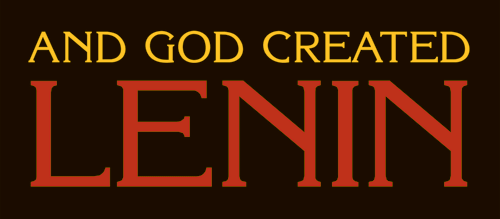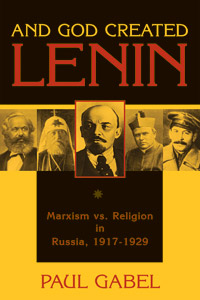
And God Created Lenin (detail of cover)
The featured article in this week’s eSkeptic is on the Soviet attempt to eradicate religion by fiat out of the Russian people. The attempt failed utterly. The historical experiment carries an important lesson for those who study belief systems in general and religion in particular: you cannot legislate beliefs and faith. Today’s atheists who are emboldened by Richard Dawkins’ Lennonesque clarion call to “imagine no religion” should read this article (and the book on which it is based) carefully, and then try to imagine another solution to the problems caused by religious extremists, for as another evolutionary biologist — Edward O. Wilson — cautioned us in his Pulitzer Prize-winning book, On Human Nature:
Skeptics continue to nourish the belief that science and learning will banish religion, which they consider to be no more than a tissue of illusions… Today, scientists and other scholars, organized into learned groups such as the American Humanist Society and Institute on Religion in an Age of Science, support little magazines distributed by subscription and organize campaigns to discredit Christian fundamentalism, astrology, and Immanuel Velikovsky. Their crisply logical salvos, endorsed by whole arrogances of Nobel Laureates, pass like steel-jacketed bullets through fog.
There is, indeed, something deeply elemental about the power of belief.
An Elemental Impulse
Religion is so Powerful that Even Soviet Antireligious Policy Failed
by Paul Gabel
The separation of church and state was so construed by the state that the churches themselves and everything that hung in them, was installed in them, and painted in them belonged to the state, and the only church remaining was that church which, in accordance with the Scriptures, lay within the heart.
While Vladimir Lenin was languishing in Europe waiting for revolution, he championed freedom of religious expression in Russia. But when he took power in November 1917, he reverted to the Marxist imperative of destruction of all religious faith — whether institutional or psychological. Marxist theory predicted that the end of class warfare would automatically lead to collapse of the class-based superstructure of religion, and Leon Trotsky held that the superstitious Russian muzhik was on the verge of atheism already — all that was needed for the whole rotting corpse to collapse was a good shove (like murdering Orthodox Patriarch Tikhon). But Lenin knew that the task would not be easy.
While the Bolsheviks worked to persuade foreign governments that no religious persecution existed in Russia, Lenin and the Cheka (secret police) decided to help Marx’s automatic process along by arresting clergy and ordering them shot, imprisoned, or exiled, often without trial.
The government spied on priests, censored their sermons, raised their taxes (as unproductive citizens), and ordered them to live outside the villages they served. It seized churches and monasteries, and reopened them as antireligious museums. It abolished religious schools and prohibited religious education until the age of 18. When a disastrous famine struck the Volga region between 1921 and 1923, the Bolsheviks used it as an excuse to confiscate gold, silver, and pearls from the churches — allegedly for famine relief but actually to line commissars’ pockets — while refusing to sell the tsar’s crown jewels to buy bread for the starving. The Orthodox Church, the Catholic Church, and others offered all non-consecrated treasures, but everything of value was stripped from places of worship.
The Bolsheviks promoted a “progressive” schism within the Orthodox Church with a panoply of communistic priests — after all, hadn’t Jesus united Palestine’s working class and ordered the wealthy to offer their riches to the poor? The government poured so many resources into this Living Church (in contrast to the Dead Church) that people began calling it the Red Church. Finally, in 1927 this tactic was abandoned in favor of support for the newly elected Patriarch Sergei, who submitted to pawn-like status.
Wild pageants erupted in the largest cities, mocking and ridiculing the Christian celebration of Jesus’s birth. Young, working-class atheists paraded through the streets carrying effigies of religious leaders of every faith they could think of. They dressed up as priests, monks, rabbis, mullahs, and shamans, while fellow demonstrators taunted and mocked them. An article in Izvestia described some of the characters: God embracing a naked woman, the Virgin Mary, the pope in a fancy motor car blessing the people, a monk riding on a coffin full of holy relics, a priest offering to marry anyone for a price, a Protestant pastor, a Jewish rabbi, a yellow-robed Buddha, Marduk of Babylon, and a group of devils with long tails and horns bringing up the rear.
For centuries monks had been manufacturing “relics” of saints using cardboard, wax, animal bones, and goat hair. The Bolsheviks discovered these frauds and filmed them so the people could see how they had been deceived. The Communist Youth League and the League of the Godless distributed millions of scientific and antireligious tracts throughout the countryside. They replaced religious holidays with workers’ holidays — the Day of Industry for the Feast of Transfiguration, and Harvest Day for the Feast of the Intercession — as if traditions could be invented. And they organized festivities on Sundays to lure young people from the churches. Bibles could no longer be printed or imported. Even the teaching of chess was marshaled to the cause — emphasis on logic would surely undermine irrational faith.
The Orthodox Church seemed such an easy target. Almost a thousand years old in Russia, it was a product of pagan and Christian syncretism. The peasants planted pagan penis figurines in their fields to encourage crop fertility and paid the local priest to sprinkle Holy Water on their crops to ward off pests. Their faith was not spiritual but habitual. They worked during the week, drank and fought on feast days, then confessed their sins and went back to the same regimen in endless cycles. Most considered priests to be magicians rather than God’s delegates on Earth. They indulged in what would seem to Westerners as the silliest of superstitions and seldom prayed for anything except better weather.
As each day went by with no divine retribution, it seemed to the Bolsheviks that they were right. If God had created Lenin, He could have uncreated him with a snap of his omnipotent fingers. And if God truly existed, why had he not done so? Surely the party had crossed any line that the Almighty might have drawn to limit the behavior of man. It would seem that they had exceeded even the transgression of Eve, yet their leaders were neither banished from Eden, turned into pillars of salt, nor consumed by fire.
Yet on days of ideological frailty they must have felt like the early Christians waiting daily for the Second Coming that never came. There was even a church revival during the 1920s as many citizens — especially the intelligentsia — rediscovered what they had lost. Nikolai Bukharin wrote words in 1919 that he could just as well have written in 1991, when the Communist experiment was over:
It has been comparatively easy for the proletarian authority to effect the separation of the church from the state and of the school from the church, and these changes have been almost painlessly achieved. It is enormously more difficult to fight the religious prejudices which are already deeply rooted in the consciousness of the masses and which cling so stubbornly to life.1
The Long Run
Religion is like a nail: the harder you hit it, the deeper it goes in. Our efforts should have been directed toward drawing it out.
While the Communists ruled Russia, religion (Christian or otherwise) never died out. It had its setbacks, to be sure — there were not enough priests, many churches were closed, and it was dangerous to be too vocal about religious ideas — but religious emotions had burrowed deeply into the Russian collective mind.
By 1936 Stalin felt that he had made progress on the antireligious front, but rumors circulated that about 40 to 45 percent of the population was still religious. Being well along in the process of wiping out all conceivable rivals to power, he was in a tolerant mood. Attending a meeting on the writing of the 1936 Constitution, he commented: “Why should the clergy be disenfranchised? Not all of them are disloyal.”2 However, the January 1937 nationwide census revealed a surprising endurance of religious sentiment; apparently many dared to check the box “believer” as a silent protest, and many who were indifferent toward religion could not quite bring themselves to check the box “unbeliever.” Stalin was furious. He could avoid embarrassment only by refusing to publish exact numbers, though the figure of 50 million believers leaked out. Another Western source claimed that 57 percent had claimed believer status, which if true would amount to some 80 million persons. These figures were astounding when we consider that respondents’ names were on the forms!
Why this religious persistence? Communists, obsessed with science, approached the churches of Russia as if they were a product of some type of malformed science. They believed that if they could simply educate the populace in “correct science,” religion would go away. Hence they scratched along the surface of religion, exposing internal contradictions, revealing the origin of gods in early man’s fear of natural forces, and ridiculing the existence of miracles.
Though this method, coming from a lack of appreciation of the deeper psychological aspects of religion, did have an effect on some individuals, it could not penetrate very far into the social psychology of the masses. Robert Casey, writing in 1946, used a different metaphor: “The Soviets accomplished little more than the pruner who cuts the leaves and surplus branches from the treetops. The result in the long run was to encourage a more healthy growth.”3 During the Great Patriotic War of the early 1940s, Stalin even had to appeal to the people’s faith to keep the country united against Hitler’s onslaught.
In the early 1960s Nikita Khrushchev, irritated with the lack of antireligious progress, ordered a new crackdown on the churches and their clergy. Completely lacking imagination (never a socialist strong point), all of the same failed tactics were regurgitated to be tried again. Believers just went underground and waited it out — time was on their side.
Eventually, as post-war standards of living inched upwards, Russians developed a certain apathy toward the church, but this does not appear to be a result of Marxist prognostications or Bolshevik tactics — rather it mirrors the Western European experience of less suffering leading to less church attendance.
Excuses abounded. In the early days, failures on the antireligious front were attributed to practical difficulties with implementation: inadequately trained cadres, poor organization, lazy workers, and communications problems. Then Soviet apologists pinned the survival of religion on carryovers from tsarist times. Marx predicted that post-revolutionary life “would be stamped with the birthmarks of the old society from whose womb it had emerged.” This still seemed a reasonable explanation for religious persistence when Emelyan Yaroslavsky, head of the League of the Godless, used it in 1923:
The human spirit is characterized by inertia. Although the body already finds itself in new relations of labor, the mind lags behind in grasping the new forms. Traditions, legends, have their hold on the brains of the living.4
Stalin’s contribution to the Marxist excuse factory was his “surrounded by capitalism” theory, arguing that since the Revolution was supposed to be international it could not come to fruition while capitalist nations existed on the Soviet periphery. While the USSR was temporarily a mere enclave of socialism waiting for ultimate world victory, religion within the country could be expected to have some life left in it.
The Even Longer Run
So long as man remains free he strives for nothing so incessantly and so painfully as to find someone to worship.
Over tens of thousands of years is such a thing as (collective) life without religion possible? Did Bolshevism have a chance of wiping this ancient way of thinking from the map of Russia and the minds of its people? In spite of their tactical blunders, were there reasons for failure beyond their control — reasons that less ideologically blinkered leaders could reasonably have been expected to understand, or at least to notice? Is there an elemental impulse toward some kind of worship?
The Protestant reformer John Calvin believed there was a semen religionis — a religious seed common to all humanity that, when expressed, could remain pure (as in his denomination) or be corrupted (as in Romanism). The German philosopher Rudolph Otto called this the sensus numinis — an innate sense of awe and longing for the otherworldly that was the basis of all concepts of god. Julian Huxley argued that religion is “a function of human nature,” but Leo Tolstoy upheld a universality of religious experience that had nothing in common with the forces of nature. It was based, he thought, upon man’s awareness of his insignificance, his isolation, and his sinfulness.
Modern-day neuroscientists have even found that stimulation of certain neurons in the temporal/limbic system of the brain can produce intense sensations of joy and visions of being in the presence of God.5
My personal theory, which is as plausible and unprovable as any other, is that a religious sense exists as a consequence of the evolutionary process. Over millions of years hominids with larger brains were favored due to their improved ability to interact socially, communicate linguistically, and obtain food. As computational power expanded, these same brains incidentally acquired the ability to grasp their loneliness in the larger world and to anticipate their own deaths. Those who could not imagine a purpose for living turned to less purposeful lives and were marginally less likely to survive to reproductive age, or even to be interested in reproduction. As people without purpose were weeded out of the gene pool, increasingly large percentages of the surviving population were capable of turning their powerful minds to thoughts of gods, whose “existence” would itself become the purpose of life. Man became an animal that could no longer “live in a world it is unable to understand.”6 The neoconservative Irving Kristol observed:
If there is one indisputable fact about the human condition it is that no community can survive if it is persuaded — or even if it suspects — that its members are leading meaningless lives in a meaningless universe.7
Perhaps we know too much for our own good.
Another explanation for the universality of religion that I find attractive imagines religion as a forward extension of the gullibility or impressionability that a child needs to learn language and culture. The child must have the capacity to trust that whatever surrounding adults say is true and useful. It is similar in process to neoteny (the retention of juvenile features in adult animals). Just as over thousands of years wolves/dogs were selected by man for retention of their adorable juvenile features and for obedience, thus retaining them into adulthood, humans’ childish acceptance — providing “answers” to the unknowable — gradually extended into adulthood in the form of religion. Faith could be simply an extension of that adaptive trait, with priests (“fathers”) as guides.
Regardless of any anthropological theory of religious origins, the ubiquity of a religious sense cannot be denied. Writing in the 1930s, the anthropologist Ruth Benedict concluded:
No matter how exotic a society the traveler has wandered, he still finds the distinction [between religious and nonreligious] made … And it is universal. There is no monograph in existence that does not group a certain class of facts as religion, and there are no records of travelers … that do not indicate this category.8
Michael Bakunin took up this issue in his 1871 God and the State, where he pointed out that universality is no more a proof of validity than was the commonly held belief that the sun revolved around the earth proof that it did. Writing in the immediate post-Darwinian world, he saw religious universality as a stage in man’s development from the animals and supported the study of religion only as a method of supplanting it as the human mind moved forward. Nonetheless, Bakunin admitted the pervasiveness and necessity of faith up to modern times. “Nothing,” he wrote, “is as universal or as ancient as the iniquitous and absurd.”
Nicolas Berdyaev (along with the Grand Inquisitor) asserted that man was by nature a spiritual being and that “the soul of man cannot live empty of religion.” Nothing can take from him the urge to venerate and adore something higher than his mere self. There is an imperative toward the superhuman.
Universality within societies implies the inherent nature of a behavior or trait. Of course, what applies to societies does not necessarily apply to every individual within that society. There is a natural sexual desire that can (sometimes) be overcome by vows of abstinence; presumably there are celibate monks and nuns, though I doubt there is one who has never entertained a sexual fantasy from the day of his or her vows. An evolved biophilic love of pastoral lands with moving fresh water can be overcome by an individual’s desire to live in the desert. In the same way individuals pledged to rationality and humanism can overcome a natural religious tendency; modern societies contain a significant minority of nonbelievers. (The Bolsheviks seem to have accomplished it, except for a smattering of “Godbuilders,” who tried to fashion a new religion out of Communism so they could fill the gaping spiritual void they, themselves, had created.)
If faith is inherent in the human condition, then the Bolsheviks were doomed from the start, for their goal was not just the physical destruction of church buildings or the legal destruction of religious institutions, but the emptying of minds of even the possibility of religious thought or emotion. Marx, Engels, and Lenin, of course, rejected the premise of a religious human nature, arguing that ever since separate social and economic classes emerged, religion had become nothing but a tool of the ruling class. The Bolshevik rejection of innateness is what led them on their hopeless quest.
Five years after the Communists lost control of greater Russia — after decades of antireligious parades, endless propaganda, and cruel persecution — Russian Orthodoxy still claims (at least nominally) almost 72 percent of the population and “no religious affiliation” claims less than 19 percent9, which is roughly the figure in America, where no such antireligious crusade occurred. That tells us something significant about the religious nature of our natures.
References
- Bukharin, Nikolai and E. Preobrazhensky. 1966. ABC of Communism — A Popular Explanation of the Program of the Communist Party of Russia. Ann Arbor: University of Michigan, 253.
- Timasheff, N.S. 1943. Religion in Soviet Russia, 1917–1942. London: Religious Book Club, 65.
- Casey, Robert Pierce. 1946. Religion in Russia. New York: Harper, 105.
- Yaroslavsky, Emelyan. 1990. “Is the Communist Movement Antireligious?” In William G. Rosenberg, Bolshevik Visions: First Phase of the Cultural Revolution in Soviet Russia, Part I. Ann Arbor: University of Michigan, 242.
- Carter, Rita. 1998. Mapping the Mind. Berkeley: University of California, 129.
- Quoted in Guthrie, Stewart Elliott. 1993. Faces in the Clouds: A New Theory of Religion. New York: Oxford University, 32.
- Quoted in Pinker, Steven. 2002. The Blank Slate: The Modern Denial of Human Nature. New York: Viking, 131.
- Quoted in Davis, Nathaniel. 1995. A Long Walk to Church: A Contemporary History of Russian Orthodoxy. San Francisco: Westview, xviii.
- Chart, Time, May 27, 1996.
Paul Gabel is the author of And God Created Lenin: Marxism vs. Religion in Russia, 1917–1929.

A Visit to the Trenches of Nontheism
Atheism is outside the mandate of the Skeptics Society and Skepticality. And yet, negative public perception of atheists weighs heavily on many nontheistic skeptics. This week’s guests discuss how this affects their work promoting science, and encourage tolerance in their daily lives.

Last episode, Skeptic publisher Dr. Michael Shermer shared his thoughts about a recently televised Nightline debate between evangelical ministers Ray Comfort and Kirk Cameron and Rational Response Squad members Brian Sapient and Kelly. Brian and Kelly contacted Skepticality, and Swoopy had a chance to talk with them this week about the work of the Rational Response Squad, and about what went on behind the scenes of the Nightline debate.

Lori Lipman Brown
Most relevant to skeptics, the gang discusses Brian’s recent involvement in a lawsuit against Uri Geller, who recently pressured online video host YouTube to remove a James Randi Nova exposé regarding his spoon-bending psychic claims.
Also, Skepticality’s Washington DC correspondent — former Nevada State Senator Lori Lipman Brown, the federal lobbyist for the Secular Coalition for America — updates Derek & Swoopy about legislative issues pertaining to nontheists.
The Rational Response Squad had far more to say than could be included in this regular Skepticality episode. For eSkeptic readers who may like to hear more, extended interview content is available in the supplement to Episode 53.
Also of interest
- ScientificAmerican.com news item about Geller‘s legal wrangling with the Rational Response Squad and YouTube.
- ABC News story and video player for Nightline debate
- Wikipedia story on Rational Response Squad.












